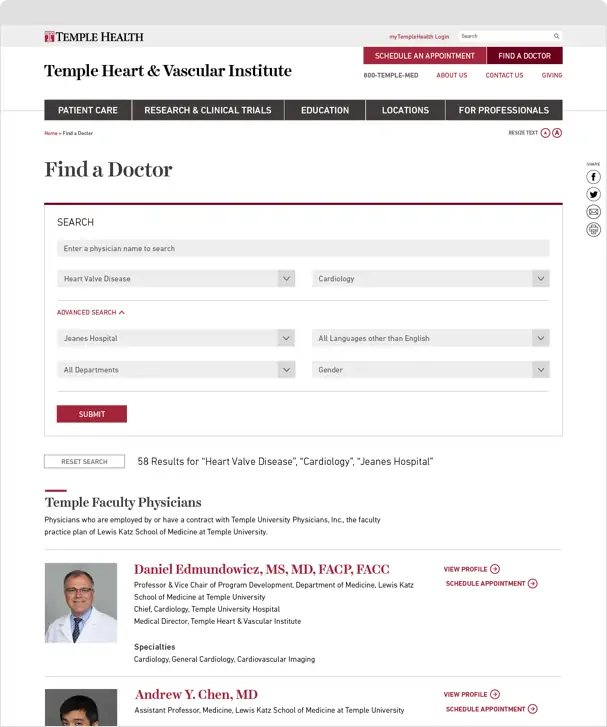Solving UX Challenges for Hospitals and Health Systems
The public website ecosystem for large healthcare organizations often comes with uniquely complex challenges.
Multiple physical locations in an organization’s network often leads to a scattered array of websites with separate databases, siloed content organization, different visual experiences for patients, and distinct brand identities. All of this confusion fights against the goals of a healthcare organization that wants to demonstrate a unified brand and provide patients a consistent experience that guides them through the organization’s full reach and service offerings. Let’s look at several of those major challenges, how to approach them, and the potential benefits that await.
Data, Data Everywhere
One of the most significant challenges healthcare organizations face when pursuing a unified user experience is the technical reality of data stored in multiple, different places, whether they hold doctors, location details, service information, or other content. Centralizing this data can be a daunting project. Despite the difficulty in centralizing content and data, the value is worth the effort involved.
The first is a greatly increased potential for a better user searching experience. Having content accessible in a single, streamlined interface lets users immediately see for themselves the reach of the organization and eliminates the frustration or confusion siloed interfaces can come with. This streamlining also encourages greater opportunities for discovery across the boundaries location-specific databases would enforce. Of course, content managers also benefit from a consolidated database and this results in less risk of outdated or conflicting information.

When approaching a consolidation effort, the starting point, beyond technical considerations, is to identify all areas of conflict between databases and thoroughly document the variety of information requirements. You’re looking to understand what information is already handled identically and what information will require a strategy for consolidating. Are office addresses handled in the same format? Do categories in different databases use the same level of granularity? Does content for one location have needs no other does? These types of questions don’t always come with easily-found or clearly-defined answers (especially when trying to answer what should happen) and every organization’s situation is unique. In our process, we utilize deep technical discoveries, content workshops, and user behavior research to make sense out of any existing chaos.
After identifying conflicts, you’ll want a strategy that isn’t just about mashing it all together. Consider the experience you want to create once the information is centralized. How necessary are all of the anomalies that will result from simply combining everything? You’ll likely find significant work is needed to make things mesh, and you may find anomalies you need to keep (such as location-specific office formats), so before you do that work, determine what an optimal experience for patients and other users will be when interacting with the interfaces.
If you are in a situation that necessitates separated databases for the same types of content, but are still pursuing a more consolidated experience, find ways to mitigate user confusion. Clearly label distinct interfaces and provide clear language that informs users why they should use one over another. This is a high-risk area for frustration and missed discovery of alternatives when done poorly.
Poor Search Optimization and Entry Points
A network of scattered, inconsistent websites will lack the search visibility that’s possible with a centralized strategy. Disconnected entry points from search lead the typical user journey to be siloed to a specific entity (whether service or location, depending on how your sites are broken up). Potentially, your users are only finding your content with keywords specifically including the entity’s name and no part of your digital content ecosystem has particular topics concentrated enough to target more generalized keywords. For example, if you have information on a particular treatment repeated in inconsistent ways across multiple sites, you are missing the opportunity to bring users to one place, demonstrate more significant traffic and interest, and increase the SEO value of that content.
Beyond SEO, consider the pathways users travel when coming in from search. If I land in the middle of your site, can I understand where I am among all available content? Or am I lost and unaware of anywhere of anything else available at your organization? Showing your organization’s full reach and making sure a user can constantly move in the direction of finding a solution to their problem in your content will greatly improve the potential of users finding a relevant reason to engage with you.
Disjointed Brand Experience
Inconsistency in content approach and design will lead to confusion and frustration. Users will not connect with your organization’s overall brand if the structure of your websites gives a feeling of distinct entities only loosely tied together, whether you want individual entities to have their own brand presence or not. You’ll need a well-considered brand strategy to balance the needs of the organization with the needs of individual entities within the network.
At Eastern Standard, we’ve learned how to walk that line and created solutions in multiple industries, including PMC Property Group’s diverse property portfolio, Temple University’s massive web network of school websites, and Temple Health’s service departments. Our approach when developing these frameworks involves a thorough understanding of not just the specific interface requirements we need to address or any specific single entity alone, but also the greater brand and the context of each entity in the ecosystem. Important steps to accomplish that include:
• Involve stakeholders early and create a content strategy informed by content experts.
• Use audience research and UX research to gather insight from actual users to inform how brands and sub-brands are already interpreted and discover how relationships are understood (or not).
• Thoroughly document content relationships. This is an opportunity to identify valuable consolidation potential and shows you where you’ll need to make clear bridges between different entities.
• Create an atomic design system, allowing you a foundation to build upon as needs inevitably change over time.
Wherever you fall on the spectrum of brand consolidation, interface consistency will strengthen the experience organization-wide and aid users when navigating throughout. A strong, consistent design system that appropriately balances your organization brand and sub-brands will also provide a reliable foundation for growth.
A Holistic Solution
For any brand’s web ecosystem, a holistic understanding of the user’s journey and user experience is critical. People online don’t follow strict paths and often don’t recognize or care about the boundaries of internal structure. Even small changes you make in pursuit of solving the problems above should be made in the context of improving the user’s overall journey. Healthcare organizations should pursue a better web experience for their audiences, not just a better element, page, or even a single website.



